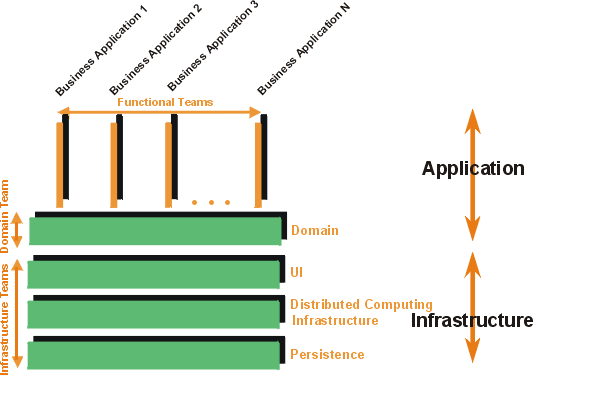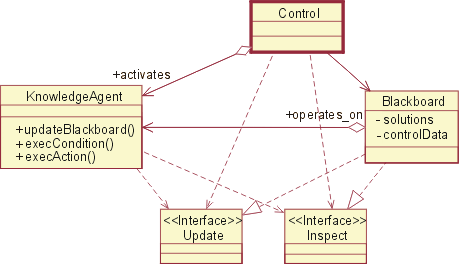| Concept: Software Architecture |
 |
|
| Related Elements |
|---|
IntroductionSoftware architecture is a concept that is easy to understand, and that most engineers intuitively feel, especially with a little experience, but it is hard to define precisely. In particular, it is difficult to draw a sharp line between design and architecture-architecture is one aspect of design that concentrates on some specific features. In An Introduction to Software Architecture, David Garlan and Mary Shaw suggest that software architecture is a level of design concerned with issues: "Beyond the algorithms and data structures of the computation; designing and specifying the overall system structure emerges as a new kind of problem. Structural issues include gross organization and global control structure; protocols for communication, synchronization, and data access; assignment of functionality to design elements; physical distribution; composition of design elements; scaling and performance; and selection among design alternatives." [GAR93] But there is more to architecture than just structure; the IEEE Working Group on Architecture defines it as "the highest-level concept of a system in its environment" [IEP1471]. It also encompasses the "fit" with system integrity, with economical constraints, with aesthetic concerns, and with style. It is not limited to an inward focus, but takes into consideration the system as a whole in its user environment and its development environment - an outward focus. In the RUP, the architecture of a software system (at a given point) is the organization or structure of the system's significant components interacting through interfaces, with components composed of successively smaller components and interfaces. Architecture DescriptionTo speak and reason about software architecture, you must first define an architectural representation, a way of describing important aspects of an architecture. In the RUP, this description is captured in the Software Architecture Document. Architectural ViewsWe have chosen to represent software architecture in multiple architectural views. Each architectural view addresses some specific set of concerns, specific to stakeholders in the development process: users, designers, managers, system engineers, maintainers, and so on. The views capture the major structural design decisions by showing how the software architecture is decomposed into components, and how components are connected by connectors to produce useful forms [PW92]. These design choices must be tied to the Requirements, functional, and supplementary, and other constraints. But these choices in turn put further constraints on the requirements and on future design decisions at a lower level. A Typical Set of Architectural ViewsArchitecture is represented by a number of different architectural views, which in their essence are extracts illustrating the "architecturally significant" elements of the models. In the RUP, you start from a typical set of views, called the "4+1 view model" [KRU95]. It is composed of:
The architectural views are documented in a Software Architecture Document. You can envision additional views to express different special concerns: user-interface view, security view, data view, and so on. For simple systems, you may omit some of the views contained in the 4+1 view model. Architectural FocusAlthough the views above could represent the whole design of a system, the architecture concerns itself only with some specific aspects:
In essence, architectural views are abstractions, or simplifications, of the entire design, in which important characteristics are made more visible by leaving details aside. These characteristics are important when reasoning about:
Architectural PatternsArchitectural patterns are ready-made forms that solve recurring architectural problems. An architectural framework or an architectural infrastructure (middleware) is a set of components on which you can build a certain kind of architecture. Many of the major architectural difficulties should be resolved in the framework or in the infrastructure, usually targeted to a specific domain: command and control, MIS, control system, and so on. Examples of Architectural Patterns[BUS96] groups architectural patterns according to the characteristics of the systems in which they are most applicable, with one category dealing with more general structuring issues. The table shows the categories presented in [BUS96] and the patterns they contain.
Two of these are presented in more detail here, to clarify these ideas; for a complete treatment see [BUS96]. Patterns are presented in the following widely used form:
Pattern NameLayers ContextA large system that requires decomposition. ProblemA system which must handle issues at different levels of abstraction. For example: hardware control issues, common services issues and domain-specific issues. It would be extremely undesirable to write vertical components that handle issues at all levels. The same issue would have to be handled (possibly inconsistently) multiple times in different components.
SolutionStructure the systems into groups of components that form layers on top of each other. Make upper layers use services of the layers below only (never above). Try not to use services other than those of the layer directly below (don't skip layers unless intermediate layers would only add pass-through components).
Pattern NameBlackboard ContextA domain in which no closed (algorithmic) approach to solving a problem is known or feasible. Examples are AI systems, voice recognition, and surveillance systems. ProblemMultiple problem-solving agents (knowledge agents) must cooperate to solve a problem that cannot be solved by any of the individual agents. The results of the work of the individual agents must be accessible to all the other agents so they can evaluate whether they can contribute to finding a solution and post results of their work.
SolutionA number of Knowledge Agents have access to a shared data store called the Blackboard. The blackboard provides an interface to inspect and update its content. The Control module/object activates the agents following some strategy. Upon activation an agent inspects that blackboard to see if it can contribute to solving the problem. If the agent determines that it can contribute, the control object can allow the agents to put its partial (or final) solution on the board.
Architectural StyleA software architecture, or only an architectural view, may have an attribute called architectural style, which reduces the set of possible forms to choose from, and imposes a certain degree of uniformity to the architecture. The style may be defined by a set of patterns, or by the choice of specific components or connectors as the basic building blocks. For a given system, some of the style can be captured as part of the architectural description in an architecture style guide-provided through the Project-Specific Guidelines work product in the RUP. Style plays a major part in the understandability and integrity of the architecture. Architectural BlueprintsThe graphical depiction of an architectural view is called an architectural blueprint. For the various views described above, the blueprints are composed of the following diagrams from the Unified Modeling Language [UML01]:
The Architecting ProcessIn the RUP, the architecture is primarily an outcome of the analysis & design workflow. As the project reenacts this workflow, iteration after iteration, the architecture evolves to become refined and polished. As each iteration includes integration and test, the architecture is quite robust by the time the product is delivered. This architecture is a main focus of the iterations of the Elaboration phase, at the end of which the architecture is normally baselined. |
© Copyright IBM Corp. 1987, 2006. All Rights Reserved. |


